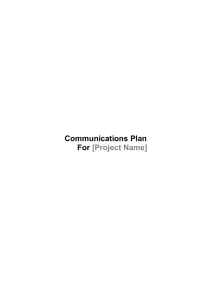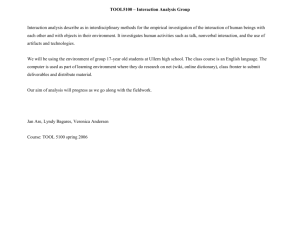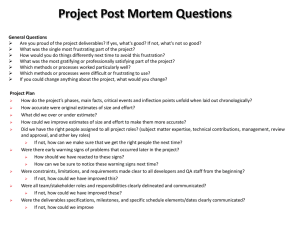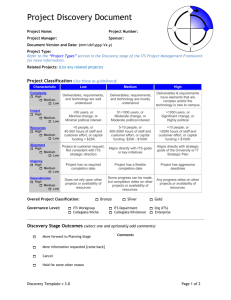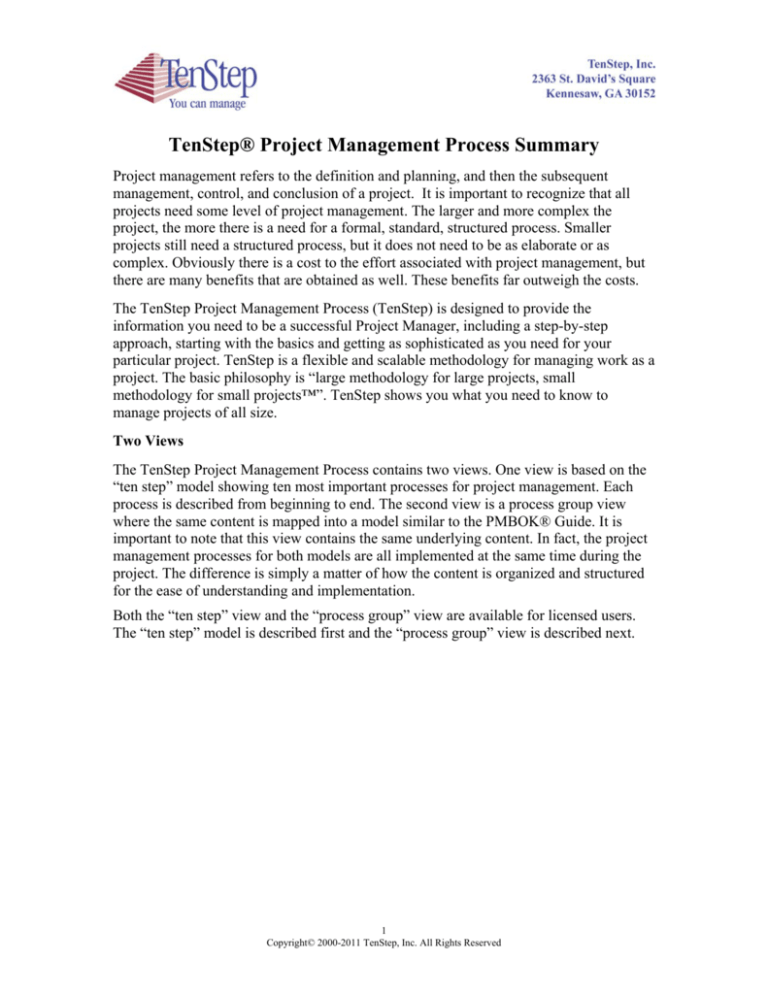
TenStep® Project Management Process Summary
Project management refers to the definition and planning, and then the subsequent
management, control, and conclusion of a project. It is important to recognize that all
projects need some level of project management. The larger and more complex the
project, the more there is a need for a formal, standard, structured process. Smaller
projects still need a structured process, but it does not need to be as elaborate or as
complex. Obviously there is a cost to the effort associated with project management, but
there are many benefits that are obtained as well. These benefits far outweigh the costs.
The TenStep Project Management Process (TenStep) is designed to provide the
information you need to be a successful Project Manager, including a step-by-step
approach, starting with the basics and getting as sophisticated as you need for your
particular project. TenStep is a flexible and scalable methodology for managing work as a
project. The basic philosophy is “large methodology for large projects, small
methodology for small projects™”. TenStep shows you what you need to know to
manage projects of all size.
Two Views
The TenStep Project Management Process contains two views. One view is based on the
“ten step” model showing ten most important processes for project management. Each
process is described from beginning to end. The second view is a process group view
where the same content is mapped into a model similar to the PMBOK® Guide. It is
important to note that this view contains the same underlying content. In fact, the project
management processes for both models are all implemented at the same time during the
project. The difference is simply a matter of how the content is organized and structured
for the ease of understanding and implementation.
Both the “ten step” view and the “process group” view are available for licensed users.
The “ten step” model is described first and the “process group” view is described next.
1
Copyright© 2000-2011 TenStep, Inc. All Rights Reserved
TenStep® “Ten Step” Classic Summary
The TenStep "steps" represent a need for more and more project management discipline
and control. So, for instance, we think all projects should be defined (step 1), even if you
do not have a schedule. Of course, as projects get to any kind of size, a schedule is
needed as well (step 2). Then if you create a schedule, you need to manage it (step 3). If
your project is small, you may not be proactively managing risk and quality, but when
problems arise, you need to handle the issues (step 4). As a project gets larger, you need
to worry about change (step 5), etc.
The bottom line is that small projects rarely have formal quality plans and they rarely
manage a metrics process. From a scalability perspective, they don't need to. However,
when you are dealing with larger and larger (longer and longer) projects, you reach a
point where all of the steps are important. The steps are inclusive of the prior steps. A
large project should be planning (step 1 and 2) and managing (steps 3 through 10) all
aspects in parallel. However, smaller projects may be focusing on a fewer number of
project management steps.
Not surprisingly, TenStep is divided into ten steps – the first two for definition and
planning, and the next eight for managing and controlling the work. This paper will
provide a high-level overview of the TenStep process and the purpose of the ten steps.
1.0 Define the Work
Before the project work begins, there needs to be time spent in planning to make sure that
the work is properly understood and agreed to by both the Project Manager and Project
Sponsor. In this step, the Project Manager spends the time defining the work to ensure
that the project team and the customer have common perceptions of the project, including
what it is going to deliver, when it will be complete, what it will cost, who will do the
work, how the work will be done, and what the benefits will be. The larger the project is,
the more important it is that these factors be mapped out formally and explicitly. All
projects should start with this type of upfront planning to prevent future problems caused
by differing viewpoints on the basic terms of the project. The major deliverable from this
step is the Project Definition (some companies call this a charter).
2.0 Build the Schedule and Budget
In this step, the Project Schedule is created. The schedule is a vital tool to ensure that the
project team knows what they need to do. Different approaches should be taken in this
step according to the size of the project. The schedule for small projects can be built
without a lot of formality. It is possible to use a project management package like MS
Project, or a spreadsheet, or a piece of paper. The Project Manager can sit down, with
other team members if appropriate, and lay out the work to be performed.
If you do not have a schedule template to use as your starting point, the Work Breakdown
Structure (WBS) technique can be used for both medium and large projects. TenStep
walks the reader through the steps to creating a schedule from scratch, starting with a
2
Copyright© 2000-2011 TenStep, Inc. All Rights Reserved
WBS, sequencing the activities and adding dependencies to create a network diagram,
adding effort hours, resources, etc.
3.0 Manage the Schedule and Budget
By now, you have created a Project Definition and a Project Schedule. Now you must
manage the schedule and ensure that it represents the current status of the project. The
schedule should be kept up-to-date and should always tell you how much work is
remaining.
For the most part, the schedule will need to be reviewed on a weekly basis. During this
review, update the schedule according to work that has been completed. It is also
important to identify work that has not been completed, but should have been at this point
in time. The remaining work should be evaluated to see if the project will be completed
within the original effort, cost, and duration. The schedule can be further adjusted
according to this information.
Other factors that should be considered when determining project progress include a
comparison of budget and actual expenditures made, any signs that the project may be in
trouble, and an examination of the project’s critical path. TenStep contains a number of
techniques to utilize if your project is behind schedule or is projected to go over budget.
For any size project, the first priority should be to complete the project within the original
estimates for effort, duration and cost. If any of the original estimates cannot be met, new
estimates need to be prepared and communicated to your management and to the
customer. On a monthly basis, adjust future work to reflect any additional information or
detail.
4.0 Manage Issues
If a problem arises that the Project Manager and the team can resolve, then it is just one
of the many fires that will ignite and be put out in a given week. However, an 'issue'
arises when a problem will impede the progress of the project and cannot be resolved by
the Project Manager and project team without outside help. This step provides guidance
to help put a process in place to make sure that the appropriate people are aware of the
issue and that the issue can be resolved as quickly as possible. There are also a number of
problem solving techniques identified to help resolve these issues.
Issues management is one of the fundamental processes of TenStep, and it is a skill that
all Project Managers must master. Most projects of any size have to deal with issues.
Once an issue has been identified and possible consequences have been investigated, it
must be resolved quickly and effectively. Issues cannot be ignored and they cannot be
deferred to some later time. Appropriate stakeholders need to be informed of any changes
to the original Project Definition caused by the issue and its resolution.
5.0 Manage Scope
3
Copyright© 2000-2011 TenStep, Inc. All Rights Reserved
It is said that the only constant in the world is “change”. You can describe the scope of
your project perfectly at a point in time, but you cannot account for every potential
change that may occur. The longer your project, the more likely you will be dealing with
changes. This is one reason why the TenStep process understands that the initial
definition (step 1) and planning (step 2) processes do not have to be perfect. You and
your team need to do the best job you can of defining scope given what you know at the
time. That is good enough. After that you need to manage the changes.
Scope is the way that we describe the boundaries and deliverables of the project. It
defines what the project will deliver and what it will not deliver, what data is needed and
what is not needed, what organizations are affected and which are not, etc. The project
deliverables are described more clearly by the requirements. Requirements are also part
of the project scope.
Without proper scope definition, you have no chance to manage scope effectively. The
purpose of scope change management is to protect the viability of the current, approved
Project Definition. When the project was defined, certain expectations were set as to what
the project was going to produce for an agreed upon cost and within an agreed upon
timeframe. If the deliverables change during the project (and usually this means that the
customer wants additional items), then the estimates for cost, effort and duration may no
longer be valid. That is really the essence and purpose of scope change management – to
ensure that the initial agreements are met, and that the project team and those same
stakeholders agree to any changes to the expectations.
6.0 Manage Communication
Properly communicating on a project is a critical success factor for managing the
expectations of the customer and the stakeholders. If these people are not kept well
informed of the project progress there is a much greater chance of problems and
difficulties due to differing levels of expectations. In fact, in many cases where conflicts
arise, it is not because of the actual problem, but because the customer or manager was
surprised.
Two typical forums for communicating status are through a Status Meeting and Status
Reports. All projects should communicate status. This includes reporting from the project
team to the Project Manager and reporting from the Project Manager to the customers and
stakeholders. While small projects usually do not require much more than basic reporting,
medium projects require a more formalized set of activities. Larger projects require the
most sophistication in how they communicate to various constituents. This multi-faceted
approach is defined in a Communications Plan.
7.0 Manage Risk
Risk refers to future conditions or circumstances that exist outside of the control of the
project team that will have an adverse impact on the project if they occur. In other words,
whereas an issue is a current problem that must be dealt with, a risk is a potential future
problem that has not yet occurred. Successful projects try to resolve potential problems
before they occur. This is the art of risk management. Risk management is a proactive
4
Copyright© 2000-2011 TenStep, Inc. All Rights Reserved
process that is invoked to attempt to eliminate potential problems before they occur, and
therefore increase the likelihood of success on the project.
Since small projects usually do not have a long duration, there is not as much opportunity
for future problems. For medium and large projects, you perform a complete assessment
of project risk when the project is defined. A risk level should then be assigned to each
risk identified, along with the likelihood that the risk will occur. Risk plans are created
for high-risk items that have a large impact on the project. Other combinations of high to
medium risks, and high to medium likelihood should also have risk plans prepared.
During the project, the Project Manager needs to monitor the risk plans to ensure they are
being executed successfully. At the end of each phase or major milestone, the Project
Manager also needs to perform an additional risk assessment based on current
circumstances.
8.0 Manage HR
A project manager is 100% responsible for the processes used to manage a project. The
project manager also has people management responsibilities, although these
responsibilities are shared with the functional managers of the team members. Some
people go as far as to say that managing people on a project is the most challenging and
the most important of all the project management responsibilities.
Managers that can manage processes but are not very good with people may still be
successful on their project. Project managers that are not good at managing processes but
are good at managing people may also experience success, although probably at a lesser
degree than the prior case. The best project managers do a good job managing the project
management processes, plus do a good job acquiring, developing and managing the
project team.
9.0 Manage Quality and Metrics
Quality is ultimately defined by the customer, and represents how close the project and
deliverables came to meeting the customer's requirements and expectations. Our goal is
to meet the customer's requirements and expectations. This is a critical point. Sometimes
there is a tendency to think that 'quality' means the best material, the best equipment and
absolutely zero defects. However, in most cases, the customer does not expect, and
cannot afford, a perfect solution.
The purpose of the quality management is to first understand the actual expectations of
the customer in terms of quality, and then put a proactive plan and process in place to
meet those expectations. One of the basic tenets of quality management is to find errors
and defects as early in the project as possible. Therefore, a good quality management
process will end up taking more effort hours and cost up-front in the project. However,
there will be a large payback as the project progresses. Small projects do not require
much more than basic quality control, but for medium and large projects, a Quality Plan
should be constructed to make sure that the project is being completed to standards.
5
Copyright© 2000-2011 TenStep, Inc. All Rights Reserved
To make the quality management process work, collecting metrics is vital.
Gathering metrics on a project is the most sophisticated project management process, and
can be the hardest. Because metrics can be hard to define and collect, they are usually
ignored. This is unfortunate because it is very difficult to improve the quality of your
deliverables or your processes if you are not gathering metrics. Metrics are used to give
some indication of what the beginning state of quality is, and whether quality is
increasing or decreasing.
Large projects should definitely be capturing metrics that will provide information on the
quality of the project and the processes used to create the deliverables. This process will
result in the creation of a Project Scorecard.
10.0 Manage Procurement
Procurement refers to the aspects of project management related to obtaining goods and
services from outside companies. This specifically refers to vendors and suppliers. This is
an area that project managers definitely need to understand at some level, and it is an area
into which the project manager will give input.
If you are purchasing goods or services on your project, you should determine your
project procurement strategy and plans. In some cases, you will simply follow the
procurement contracts and plans that are already established by your company or your
organization. In some cases, you will need to work with your Procurement Department to
establish your own project-level vendor management plans.
6
Copyright© 2000-2011 TenStep, Inc. All Rights Reserved
TenStep® Process View Summary
1.0P Initiate the Project
The TenStep Project Management Process describes how to proactively plan and manage
projects. However, this assumes that there is a project to begin with. Every organization
has processes in place to identify and authorize a project. This process generally has the
following characteristics.
•
Some way to identify all of the possible projects that could be started.
•
A funneling process to narrow down all of the possible processes into the smaller
number that have the most value and are most aligned to the business goals and
strategies.
•
A means to document the costs and benefits so that the project can be compared to
other projects. This document is generally called a Business Case.
•
Identification of a minimum set of high-level information required to gain final
approval of the project.
The process described above is used to gain preliminary approval for a project. However,
there may be a time lag between the time when a project is initially approved, and the
time the project actually starts. Therefore, when a project is ready to begin, there are a
number of items that must be validated to ensure that the project is ready to start.
2.0P Plan the Project
The Initiation process validates that the project is ready to start. You have ensured the
project is still valid, the sponsor is ready and the project manager is in place. However,
you are not ready to actually begin executing the project and building the deliverables. At
this point you don’t know the deliverables, the resources required, the timeframe, the
schedule, the risks, etc. Yes, you might know this information at a very high level from
the Business Case. But you don’t know nearly enough details to be able to actually start
project execution.
Before you begin execution you must first plan. If you have a small project the planning
may be relatively easy and short. Perhaps it is just validating the deliverables, creating a
task list, understanding the client expectations and then start. On the other hand, a very
large project may take weeks or months to plan at the level that is appropriate enough to
begin execution. The answer to the question of “how long should you take to plan a
project” is “sufficient time”.
This is a key point. You need to plan at a “sufficient” level to be confident of success. If
you do not plan enough, there is a good chance you will encounter problems and not be
as successful as you want to be. If you spend too much time planning you are not
providing value and you are wasting time and resources that you could be spending
executing.
The planning process contains many potential elements and it is important to understand
which elements are of value to you. Generally the larger your project, the more elements
7
Copyright© 2000-2011 TenStep, Inc. All Rights Reserved
will be of value. For example, if you have a project that does not have a vendor
component, the Vendor Management Plan will not be relevant. If you have a very large
project with multiple important and integrated vendors, the Vendor Management Plan
may be absolutely vital.
3.0P Execute Project Management Processes on Your Project
After the project has been planned it is time to begin executing the project lifecycle. At
this point, two of the project management process groups come into the forefront to
manage the project. Some of these processes are classified as “executing” and some are
classified as “monitor and control”. The biggest different is that the executing processes
are those that are proactively carried out by the project manager. For instance, managing
issues is a proactive project management process. There is no baseline for issues. When
an issue arises, the project manager needs to address it through issues management.
4.0P Monitor and Control the Project
The second project management process that occurs as the project is progressing is
“monitor and control”. This set of process is more reactive. You first make a baseline
plan, and then monitor the project to detect a change to the baseline. When you detect the
change, you take action.
For example, the scope management is a process of monitoring the project scope. IF the
scope changes (from the baseline version) the project manager invokes scope change
management. Likewise you have built a schedule for your project. You need to monitor
progress against your schedule. If you remain on schedule and your schedule continues to
represent the path to project completion, you may not have to update it again. IF you
detect a variance against your schedule, corrective actions may be necessary. This is the
nature of project management activities that are in this monitor and control section.
5.0P Close the Project
Just as it is important to formally kick off a project, it is also important to successfully
close the project. The value of having a planned project termination is in leveraging all of
the information and experience gathered throughout the project. If the solution is
implemented and the team immediately disbands, you don’t have an opportunity to wrap
up the loose ends, do staff evaluations, document key learnings or ensure that appropriate
deliverables are transitioned to support. Of course, a project can end unsuccessfully as
well. Even in this case, there are key learnings, team evaluations and other wrap-up
activities to make the most of what was done on the project.
8
Copyright© 2000-2011 TenStep, Inc. All Rights Reserved


